This set of Basic Electrical Engineering Multiple Choice Questions & Answers (MCQs) focuses on “Nodal Analysis”.
1. Find the value of the node voltage V.
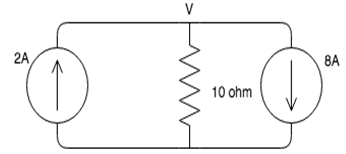
a) -60V
b) 60V
c) 40V
d) -40V
View Answer
Explanation: The node equation is:
-2+8+V/10=0 => 6 + v/10 = 0 => v = -10*6 = -60V
Solving this equation, we get V = -60V.
2. Calculate the node voltages V1 and V2.
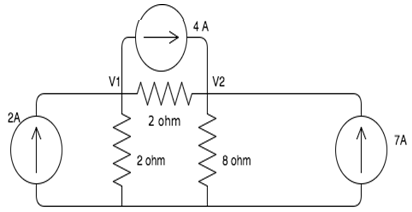
a) 12V, 13V
b) 26.67V, 11.33V
c) 11.33V, 26.67V
d) 13V, 12V
View Answer
Explanation: The nodal equations are:
2V1-V2=-4
-4V1+5V2=88
Solving these equations simultaneously, we get V1=11.33V and V2=26.67V.
3. Find the node voltage V.
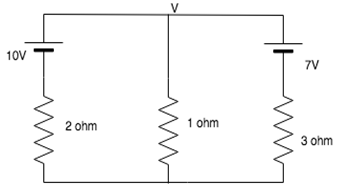
a) 1V
b) 2V
c) 3V
d) 4V
View Answer
Explanation: The nodal equation is:
(V-10)/2+(V-7)/3+V/1=0
Solving for V, we get V=4V.
4. Calculate the node voltages.
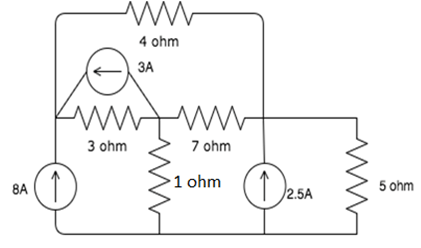
a) 30.77V, 7.52V, 18.82V
b) 32.34V, 7.87V, 8.78V
c) 34.34V, 8.99V, 8.67V
d) 45.44V, 6.67V, 7.77V
View Answer
Explanation: The nodal equations, considering V1, V2 and V3 as the first, second and third node respectively, are:
-8+(V1-V2)/3-3+(V1-V3)/4=0
3+V2+(V2-V3)/7+(v2-V1)/3=0
-2.5+(V3-V2)/7+(V3-V1)/4+V3/5=0
Solving the equations simultaneously, we get V1=30.77V, V2=7.52V and V3=18.82V.
5. Find the value of V1 and V2.
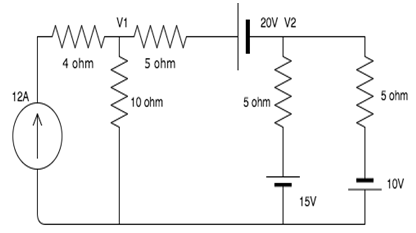
a) 87.23V, 29.23V
b) 23.32V, 46.45V
c) 64.28V, 16.42V
d) 56.32V, 78, 87V
View Answer
Explanation: The nodal equations are:
0.3V1-0.2V2=16
-V1+3V2=-15
Solving these equations simultaneously, we get V1=64.28V and V2=16.42V.
6. Nodal analysis is generally used to determine_______
a) Voltage
b) Current
c) Resistance
d) Power
View Answer
Explanation: Nodal analysis uses Kirchhoff’s Current Law to find all the node voltages. Hence it is a method used to determine the voltage.
7. If there are 10 nodes in a circuit, how many equations do we get?
a) 10
b) 9
c) 8
d) 7
View Answer
Explanation: One node is taken as reference node so, the number of equations we get is always one less than the number of nodes in the circuit, hence for 10 nodes we get 9 equations.
8. Nodal analysis can be applied for________
a) Planar networks
b) Non-planar networks
c) Both planar and non-planar networks
d) Neither planar nor non-planar networks
View Answer
Explanation: Nodal analysis can be applied for both planar and non-planar networks since each node, whether it is planar or non-planar, can be assigned a voltage.
9. How many nodes are taken as reference nodes in a nodal analysis?
a) 1
b) 2
c) 3
d) 4
View Answer
Explanation: In the nodal analysis, one node is treated as the reference node and the voltage at that point is taken as 0.
Sanfoundry Global Education & Learning Series – Basic Electrical Engineering.
To practice all areas of Basic Electrical Engineering, here is complete set of 1000+ Multiple Choice Questions and Answers.
If you find a mistake in question / option / answer, kindly take a screenshot and email to [email protected]
